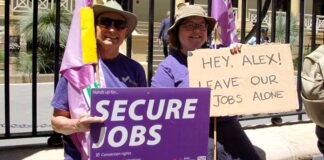Treasurer Jim Chalmers has declared “productivity” a centrepiece of the Labor government’s second term agenda.
Chalmers used his National Press Club speech in June to promote an upcoming economic round-table where 25 business, union and civil society groups will be brought together to discuss productivity, tax changes to deliver budget “sustainability”, and economic resilience.
Chalmers’ campaign about productivity is another indicator of the way Labor plans on pandering to big business instead of taking real action on the cost of living crisis.
Instead of using its huge majority to address inequality and improve workers’ lives, Chalmers wants to imitate the “economic reform” agenda of the Hawke and Keating Labor governments that drove down wages and delivered mass sackings.
The focus on productivity comes straight out of the wish list of big business lobby group the Business Council of Australia (BCA).
It has been beating the drum about “productivity” since well before the last election.
Back in 2023 its newly appointed chief Bran Black said his priority would be, “very much on the productivity levers that can be pulled across the board.”
For Black these “levers” include industrial relations, deregulation and tax reform: attacking workers’ rights, cutting taxes on business profits and reducing regulations like those that protect the environment.
When bosses and the BCA talk about “increasing productivity” they really mean generating more profits for themselves.
In June Bran Black said that the BCA, “would love to see company tax reduced”.
In the lead up to the summit the government has said it is considering new hand-outs for business including “tax incentives for new capital expenditure” and “streamlined major project approvals”.
In his National Press Club speech Jim Chalmers also pointed to planned government spending under the banner of Future Made in Australia as part of the productivity drive.
This includes a fortune for arms manufacturers from $50 billion of military spending.
What is productivity?
Productivity refers to the level of output the economy generates compared to its inputs—most importantly how much can be produced with a given amount of labour.
It can be increased through new labour-saving technology, for example robots or other machinery, but also through squeezing workers to work more intensely.
An example of how the push for productivity means increased work intensity is the widespread use of invasive software like Controlio. This is used for surveillance of employees who use computers and can track “active time” to generate a “productivity score”. This kind of software can record keystrokes and mouse movement, take screenshots, trace location, and even activate webcams and microphones.
In his National Press Club speech Jim Chalmers said that boosting productivity was about delivering “a better standard of living than we enjoy today.” This is rubbish.
Productivity increases often see companies sack workers, because they allow them to churn out the same level of production with less staff.
The productivity surge in 1990-91 during the Hawke-Keating years resulted in mass sackings and higher unemployment. The Australia Institute points out that: “firms instead sacked workers in their thousands and gave Australia an unemployment rate of 12 per cent by 1992. Productivity grew because there were fewer people working.”
Recent increases in productivity have been going straight into corporate pockets, not to workers through higher wages.
According to analysis published by the Australia Institute, between 2000 and 2023 there was a 28 per cent increase in productivity while hourly wages went up just 10 per cent. In the ten years between 2012 and 2022 productivity economy-wide increased by 11 per cent but real wages fell by 0.2 per cent. As a result the wages share of GDP hit a new record low.
The jobs wipe-out in major supermarket warehouses also shows what the reality of increased “productivity” can mean.
Both Woolworths and Coles have invested hundreds of millions in new automated warehouses to boost profits. Woolworths announced a wave of warehouse automation in 2020 saying it would mean 700 job cuts. Coles workers have faced a similar fate. Over 350 warehouse workers at Coles Smeaton Grange were disgracefully locked out for three months after they demanded better redundancy entitlements in the face of automation and warehouse closure in 2020.
Chalmers says Artificial Intelligence is another “key part of our productivity agenda” where there are “huge gains on offer” for business—dismissing union demands for “guardrails” through regulation to defend workers’ jobs.
Workers have no interest in boosting bosses’ profits or productivity. We need a bigger share of the profit workers already produce and relief from the cost of living crisis. But the only way to get that is to fight for it.
By Adam Adelpour






